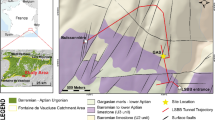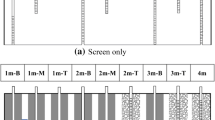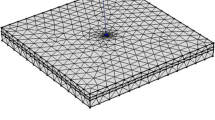Abstract
A permeability test in a monitoring well (MW) is used to assess the hydraulic conductivity, k, of clay. To interpret the test data, the piezometric level (PL) during the test must be known. A previous paper has concluded that due to a long time lag, the water level in the pipe is never a PL and any extrapolation of water level versus time gives an unreliable prediction of the PL. As a result, an incorrect PL yields an incorrect k value. This paper shows that a variable-head permeability test can provide a fair estimate of both the PL and the k value when it is interpreted using the central portion of the velocity graph. The first portion of the graph, when the head difference and the gradients are high, is curved by the expansion of the injection zone (undrained and drained wall displacement with eventually some creep), and thus cannot be used. The last portion of the graph primarily reflects, with some time lag, the natural variations of hydraulic heads in adjacent aquifers, and thus must not be used.
Résumé
Un essai de perméabilité dans un piézomètre sert à évaluer la conductivité hydraulique, k, d’une argile. Pour interpréter les données d’essai, le niveau piézométrique (NP) pendant l’essai doit être connu. Un article précédent a conclu qu’à cause d’un long délai de réponse, le niveau d’eau dans le tuyau n’est jamais un NP, et toute extrapolation du niveau d’eau en fonction du temps donne une prédiction peu fiable du NP. Par conséquent, un NP incorrect conduit à une valeur incorrecte de k. Cet article montre qu’un essai de perméabilité à niveau variable peut donner une bonne évaluation du NP et de k quand on l’interprète à l’aide de la partie centrale du graphe des vitesses. La première partie du graphe, quand la différence de charge et les gradients sont élevés, est incurvée par l’expansion de la zone d’injection (déplacement non drainé et drainé de la paroi, avec éventuellement du fluage), et ne peut donc pas être utilisée. La dernière partie du graphe reflète surtout, avec un certain retard, les variations naturelles des charges hydrauliques dans les aquifères adjacents, et ne doit donc pas être utilisée.
















Similar content being viewed by others
References
AFNOR (1992) Norme NF P94–132. Essai d’eau Lefranc, Paris
Baguelin F, Jézéquel JF, Shields DH (1978) The Pressuremeter and Foundation Engineering. Trans-Tech. Publications, Switzerland, p 617
Bardet JP (1997) Experimental Soil Mechanics. Prentice Hall, Upper Saddle River
Benabdallah EM, Chapuis RP (2007) Étude des effets d’échelle sur la perméabilité d’une argile Champlain. In: Proceedings of 60th Can Geotech Conference and 8th Joint Conference CGS/IAH-CNC, Ottawa, p 9
Benson CH, Gunter J, Boutwell G, Trautwein S, Berzanskis P (1997) Comparison of four methods to assess hydraulic conductivity. ASCE J Geotech Geoenvir Eng 123(10):929–937
Bjerrum L, Nash JKTL, Kennard RM, Gibson RE (1972) Hydraulic fracturing in field permeability testing. Géotechnique 22(2):319–332
Bouwer H, Rice RC (1976) A slug test for determining hydraulic conductivity of unconfined aquifers with completely or partially penetrating wells. Water Resour Res 12(3):423–428
Bowles JE (1997) Foundation analysis and design. McGraw-Hill, New York
CAN/BNQ 2501-130-M88 (2008) Soils-Determination of permeability at the end of a casing. National Standard of Canada
CAN/BNQ 2501-135-M88 (2008) Soils-Determination of permeability by the Lefranc method. National Standard of Canada
Cassan M (1980) Les essais d’eau dans la reconnaissance des sols. Eyrolles, Paris
Cassan M (2000) Application des essais Lefranc à l’évaluation du coefficient d’anisotropie hydraulique des sols aquifères. Rev Fr Géotech 90:25–43
Chapuis RP (1989) Shape-factors for permeability tests in boreholes and piezometers. Ground Water 27(5):647–654
Chapuis RP (1990a) Sand-bentonite liners: field control methods. Can Geotech J 27(2):216–223
Chapuis RP (1990b) Sand bentonite liners: predicting permeability from laboratory tests. Can Geotech J 27(1):47–57
Chapuis RP (1992a) Fracturing pressure of soil ground by viscous materials: discussion. Soils Found 2(3):174–175
Chapuis RP (1992b) Similarity of internal stability criteria for granular soils. Can Geotech J 29(4):711–713
Chapuis RP (1998a) Overdamped slug test in monitoring wells: review of interpretation methods with mathematical, physical and numerical analyses of storativity influence. Can Geotech J 35(5):697–719
Chapuis RP (1998b) Poor borehole sampling and consequences for permeability evaluation. In: Proceedings of 8th Congress IAEG, Vancouver, Balkema, vol 1, pp 417–423
Chapuis RP (1999) Borehole variable-head permeability tests in compacted clay liners and covers. Can Geotech J 36(1):39–51
Chapuis RP (2001) Extracting piezometric level and hydraulic conductivity from tests in driven flush-joint casings. Geotech Test J 24(2):209–219
Chapuis RP (2002) The 2000 R.M. Hardy Lecture: full-scale hydraulic performance of soil-bentonite and compacted clay liners. Can Geotech J 39(2):417–439
Chapuis RP (2004) Predicting the saturated hydraulic conductivity of sand and gravel using effective diameter and void ratio. Can Geotech J 41(5):787–795
Chapuis RP (2005a) Numerical modeling of rising-head permeability tests in monitoring wells after lowering the water level down to the screen. Can Geotech J 42(4):705–715
Chapuis RP (2005b) Using the velocity graph method to interpret rising-head permeability tests after dewatering the screen. Geotech Test J 28(3):305–312
Chapuis RP (2006) Interpreting variable-head tests performed in open holes or monitoring wells with several screens. Geotech Test J 29(6):467–473
Chapuis RP (2007) References on field permeability tests performed in boreholes and monitoring wells. Tech. Report EPM-RT-07-04, École Polytechnique, Montréal, URL: http://www.polymtl.ca/biblio/epmrt/rapports/rt2007-04.pdf
Chapuis RP (2008) Installing a gravel pack or filter pack for a monitoring well. Geotech News 26(4):45–47
Chapuis RP (2009a) Monitoring well in a clay layer: revisiting the time lag problem. BEGE 68(3):387–395
Chapuis RP (2009b) Field variable-head test in low-permeability materials: assessing the effects of trapped gas pocket and cavity expansion. Can Geotech J 46(1):81–92
Chapuis RP (2009c) Numerical modelling of reservoirs or pipes in groundwater seepage. Comput Geotech 36(5):895–901
Chapuis RP (2009d) Variable head permeability tests in monitoring wells: comparing the shape factor defined by Bouwer and Rice (1976) to the shape factor given by Hvorslev (1951). Geotech News 27(1):41–43
Chapuis RP (2009e) Interpreting slug tests with large data sets. Geotech Test J 32(2):139–146
Chapuis RP (2009f) Permeability or hydraulic conductivity tests in a monitoring well: why are piezometric level corrections required? Geotechnical News 27(2):46–49
Chapuis RP (2012) Predicting the saturated hydraulic conductivity of soils: a review. Bull Eng Geology Envir 71(3):401–434
Chapuis RP, Cazaux D (2002) Pressure-pulse test for field hydraulic conductivity of soils: is the usual interpretation method adequate? In: Sara MN, Everett LG (eds) Evaluation and Remediation of Low and Dual Porosity Environments, STP 1415. ASTM International, West Conshohocken, pp 66–82
Chapuis RP, Chenaf D (2002) Slug tests in a confined aquifer: experimental results in a large soil tank and numerical modeling. Can Geotech J 39(1):14–21
Chapuis RP, Chenaf D (2003) Variable-head field permeability tests in driven flush-joint casings: physical and numerical modeling. Geotech Test J 26(3):245–256
Chapuis RP, Chenaf D (2008) Shape factors for constant-head double-packer permeameters: comment. Water Resour Res 44:W07601. doi:10.1029/2007WR006727
Chapuis RP, Sabourin L (1989) Effects of installation of piezometers and wells on groundwater characteristics and measurements. Can Geotech J 26(4):604–613
Chapuis RP, Paré JJ, Lavallée JG (1981) Essais de perméabilité à niveau variable. In: Proceedings 10th international conference on soil mechanics and foundation engineering, Stockholm, Balkema, vol 1, pp 401–406
Chapuis RP, Lavoie J, Girard D (1992) Design, construction, performance and repairs of the soil-bentonite liners of two lagoons. Can Geotech J 29(5):638–649
Chapuis RP, Chenaf D, Bussière B, Aubertin M, Crespo R (2001) A user’s approach to assess numerical codes for saturated and unsaturated seepage conditions. Can Geotech J 38(5):1113–1126
Chapuis RP, Dallaire V, Gagnon F, Marcotte M, Chouteau M (2007) Falling-head permeability tests using monitoring wells in unconfined aquifers. Geotech Test J 30(2):104–112
Chesnaux R, Chapuis RP (2007) Detecting and quantifying leakage through defective borehole seals: a new methodology and laboratory verification. Geotech Test J 30(1):17–24
Chesnaux R, Chapuis RP, Molson JW (2006) A new method to characterize hydraulic short-circuits in defective borehole seals. Ground Water 44(5):676–681
Chiasson P (2005) Methods of interpretation of borehole falling-head tests performed in compacted clay liners. Can Geotech J 42:79–90
Cooper HH Jr, Bredehoeft JD, Papadopulos IS (1967) Response of a finite-diameter well to an instantaneous change of water. Water Resour Res 3(1):263–269
Daniel DE (1989) In situ hydraulic conductivity tests for compacted clay. ASCE J Geotech Eng 115(9):1205–1226
Dixon N, Bromhead EN (1999) Depth-dependent permeability in London clay measured using standpipe piezometer equilibration data. Geotechnique 49(5):651–660
Duhaime F, Chapuis RP (2008) Evaluating the effects of clay compressibility during field permeability tests. In: Proceedings of 61st Canadian geotechnical conference, Edmonton, Sept. 21–24, 2008, pp 1455–1459
Fredlund DG, Morgenstern NR (1976) Constitutive relations for volume change in unsaturated soils. Can Geotech J 13:261–276
Fredlund DG, Morgenstern NR (1977) Stress state variables for unsaturated soils. ASCE J Geotech Eng 103:447–466
Geoslope (2003) Seep/W for finite element seepage analysis. User’s Guide, Version 5. Geoslope International, Calgary, Alberta
Gibson RE (1970) An extension to the theory of the constant-head in situ permeability test. Géotechnique 20(2):193–197
Gibson RE, Anderson WF (1961) In situ measurements of soil properties with pressuremeter. Civil Eng (London) 56:615–618
Guyonnet D, Mishra S, McCord J (1993) Evaluating the volume of porous medium investigated during slug tests. Ground Water 31(4):627–633
Hvorslev MJ (1951) Time lag and soil permeability in ground water observations. Bulletin 36, U.S. Army Corps of Engineers, Waterways Experimental Station, Vicksburg, Miss
Jacob CE (1950) Engineering Hydraulics., Flow of ground waterJohn Wiley and Sons, New York, pp 321–386 (Chapter 5)
Keller CK, van der Kamp G (1992) Slug tests with storage due to entrapped air. Ground Water 30(1):2–7
Lamé G (1852) Leçons sur la théorie mathématique d’élasticité des corps solides. Bachelier, Paris
Lamé G (1861) Leçons sur la théorie analytique de la chaleur. Mallet-Bachelier, Paris
Lefèbvre G, Philibert A, Bozozuk M, Paré JJ (1981) Fissuring from hydraulic fracturing of clay soil. Proc., 10th Int Conf Soil Mech Found Eng. 2:513–518
Lefranc E (1936) Procédé de mesure de la perméabilité des sols dans les nappes aquifères et application au calcul du débit des puits. Le Génie Civil, CIX(15):306–308
Lefranc E (1937) La théorie des poches absorbantes et son application à la détermination du coefficient de perméabilité en place et au calcul du débit des nappes d’eau. Le Génie Civil, CXI(20):409–413
Lewis RW, Schrefler B (1978) Fully coupled consolidation model of the subsidence of Venice. Water Resour Res, 14(2):223–230
Lewis RW, Schrefler BA (1998) The finite element method in the static and dynamic deformation and consolidation of porous media. John Wiley and Sons, New York
Mandel J (1939) Note sur le calcul des infiltrations. Annales des Ponts et Chaussées, Juillet, pp 57–110
Maxwell JC (1873) Treatise on Electricity and Magnetism, 1st edn. Clarendon Press, Kensington
Mieussens C, Ducasse P (1977) Mesure en place des coefficients de perméabilité et des coefficients de consolidation horizontaux et verticaux. Can Geotech J 14(1):76–90
Randolph MF, Wroth CP (1979) Analytical solution for the consolidation around a driven pile. Int J Numer Anal Meth Geomech 3(3):217–229
Richards LA (1931) Capillary conduction of liquids through porous medium. Physics 1:318–333
Schneebeli G (1966) Hydraulique souterraine. Eyrolles, Paris, p 362
Taylor DW (1948) Fundamentals of Soil Mechanics. Chapman and Hall, London, p 194
Terzaghi K, Fröhlich OK (1936) Theorie der Setzung von Tonschichten. Deutike, Leipzig 166 p
Wilkinson WB (1968) Constant-head in situ permeability tests in clay strata. Géotechnique 18(2):172–194
Acknowledgments
This paper is a result of a research program involving theoretical analysis and fieldwork designed to improve the reliability of permeability and aquifer tests and sponsored by the Natural Sciences and Engineering Council of Canada.
Author information
Authors and Affiliations
Corresponding author
Rights and permissions
About this article
Cite this article
Chapuis, R.P., Duhaime, F. & Benabdallah, E.M. Monitoring wells in clay: the apparently static water level and its influence during variable-head permeability tests. Bull Eng Geol Environ 71, 663–678 (2012). https://doi.org/10.1007/s10064-012-0433-8
Received:
Accepted:
Published:
Issue Date:
DOI: https://doi.org/10.1007/s10064-012-0433-8




